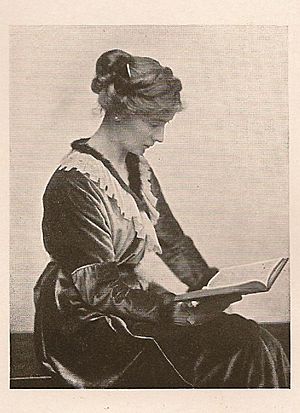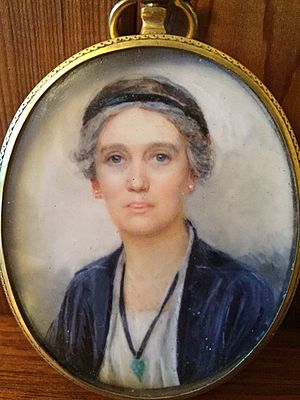Elizabeth Clark (author) facts for kids
Quick facts for kids
Elizabeth Clark
|
|
|---|---|

Elizabeth Clark, about 1915
|
|
| Born | 14 May 1875 Hartlebury, Worcestershire, United Kingdom
|
| Died | 21 April 1972 (aged 96) Winchester, Hampshire, United Kingdom
|
| Resting place | Kilmeston, Hampshire, United Kingdom |
| Occupation | Story teller, lecturer, author |
| Years active | 1915–1955 |
Annette Elizabeth Clark (born May 14, 1875 – died April 21, 1972) was a famous storyteller. Her family called her Nettie. She was known for telling children's stories, teaching others how to tell stories, and writing ten books of children's tales. Her stories were even shared on BBC children's radio shows.
Contents
Elizabeth Clark's Early Life
Elizabeth Clark was born in 1875. She was the oldest of six children. Her parents were Reverend William Maitland Clark and Annette Laura Clark. They lived in Hartlebury, where her father was the headmaster of a school.
When Elizabeth was four, her family moved to another school in Hampstead. Around 1883, they moved to Kingsgate House in Winchester. There, her father started a school for young boys. The family lived at Kingsgate House until 1904. Elizabeth and her sisters were some of the first students at the Winchester High School for Girls, which is now called St Swithun's.
Later, her father became the vicar (a type of priest) in Kilmeston, a village near Winchester. As the oldest daughter in a vicar's family, Elizabeth was expected to help with church and village activities. She soon found out she had a special talent for telling stories. She could capture the attention of the village children with her fairy tales. She decided she wanted to make storytelling her life's work. So, she moved to London to follow her dream.
In 1915, Elizabeth was asked to tell stories regularly at new places called Play-Centres. The next year, she gave lessons on storytelling at an education center. She even created a pamphlet to promote her work. It included good reviews from newspapers. One article in the Evening Standard said:
Miss Elizabeth Clark is an idealist. Her stories are related with a sympathetic understanding of what a child wants to know ... She can carry the children with her not only into the well-known world of Grimm and Anderson but along routes of old saga for which East and West are alike responsible.
This means she was great at understanding what kids wanted to hear. She could take them on adventures through stories from all over the world.
Storytelling After World War I
After World War I, in 1919, the London County Council hired Elizabeth to teach storytelling to teachers in London. She did this twice a year for more than ten years. She also taught many students at teacher training colleges in Scotland.
In 1931, the leaders of the National Girl Scouts of the USA invited her to speak at their meetings in the East and Mid-West of America. After a two-month tour, she returned to England. She then gave a talk in Hull about storytelling in America. The Hull Daily Mail newspaper wrote about her:
As I write I cannot help still thinking of the delightful way of story-telling which is possessed by Miss Elizabeth Clark, who spoke at the Women's Luncheon Club, Hull, on the art of story-telling in America. I remembered her as soon as she began, and the fact that she had been to the Luncheon Club before, and had enchanted me especially with the tale of a hungry family finding a cabbage in their garden which grew and grew until they had enough to make a good meal and soup for the whole family even giving the "Little Moose a cup o' soup", to use the wording of a child to whom she had previously told it.
She really is a refreshing person, and makes one feel young again as well as becoming extremely envious of her art. I think, too, she makes our next feeble attempt at story-telling easier, because she makes you realise that to understand a story people must really “see” in their mind the objects spoken of. She always gives a vivid picture, and you have no doubt as to what the people in the story are like, what the surroundings look like.
This newspaper article shows how much people loved her storytelling. She made stories come alive and helped listeners imagine everything clearly.
In 1933, Elizabeth published a book called Twenty Tales for Telling. She dedicated it to the Girl Scouts of the USA. The book included a story called Jack-in-the-Pulpit, which was based on her travels in New England. A reviewer named Alexander Haddow wrote about her amazing storytelling power:
Those who have heard her tell a story know what a perfect artist she is, how she lives her part, what perfect command of her voice and what a gift of expression she has.
He also said that her stories, even in print, kept her special charm. He noted:
There's a sweetness in her English and a simplicity both in vocabulary and construction that make it particularly suitable for children.
Elizabeth lived in the Notting Hill area of London between the two World Wars. Before World War II, she moved back to Winchester. She lived there with her sister Dorothy, who taught math at St. Swithun's school. Elizabeth continued to give talks and tell stories often in England and Scotland.
Her stories were broadcast on the BBC children's radio show, Children's Corner, from 1924 to 1926. Sometimes she told them herself, and sometimes others did. Her stories were also heard during the war years (1940-1944) and later from 1961-1965 on another show called Children's Hour. Some of her tales were even shown on the BBC's TV programme Jackanory in 1979.
In 1951, Elizabeth wrote to a college in Aberdeen, saying it would be hard for her to visit regularly anymore. However, she kept telling stories closer to home. She passed away in Winchester in April 1972 and was buried in Kilmeston.
In 1995, Winchester City Council held a literary festival. It included an exhibition called Hampshire Daughters. This show featured three important women writers with ties to Winchester: Jane Austen, Charlotte Mary Yonge, and Elizabeth Clark. Each was born about 50 years apart.
Elizabeth Clark's Storytelling Style and Sources
Elizabeth Clark found ideas for her stories from many places. She used folklore from around the world, history, legends, and even the Bible. In her books like Stories to Tell and How to Tell Them and More Stories and how to Tell Them, she included tips on how to tell or read each story.
She often explained where she found a legend and how she changed it to make it her own. For example, in The Old Woman and the Pixies and the Tulips, she described the little white house and its garden in great detail. She believed it was important to set the scene slowly so listeners could clearly imagine the story's world. She wrote, "...unless listeners have a perfect idea of the "geography" of the story, they will not be able to grasp the situation as they should".
Many of her stories had a lesson or a moral. For instance, in the Norse folk-tale Jonathan John and his Wife, she made sure to balance the story. Other tales like The Old Woman who Lived in a Vinegar Bottle and Good Luck and Mrs Featherfuss also had lessons. But Elizabeth often let the reader or listener decide what that lesson was for themselves.
She also told stories from the Bible, such as Moses and Miriam in The Little Ark of Rushes. Other legendary stories she shared came from places like the Middle East, Japan, India, and Russia.
Elizabeth sometimes used her own childhood experiences in her stories. The Elizabeth Ann Stories were about a girl named Elizabeth Ann and her younger sister, Ruth Mabel (who was her real-life sister). Many of her stories first appeared in a magazine called Child Education. For example, between 1944 and 1946, she published seven short stories about a girl named Polly and her great-grandmother. These were later put into a book called Sunshine Tales for Rainy Days.
One of her original stories, Father Christmas and the Donkey, was first published in 1942. She wrote it after the London Blitz during World War II. It was meant for children who had to leave their homes because of the bombings. The boys in the original story were children who had been evacuated from London.
Elizabeth Clark loved animals, and this love showed in her stories. Sometimes her tales were just about animals interacting, like Father Sparrow's Tug of War. Other times, they showed how humans and animals depend on each other, as in Robin Redbreast's Thanksgiving and, of course, Father Christmas and the Donkey.
Images for kids






